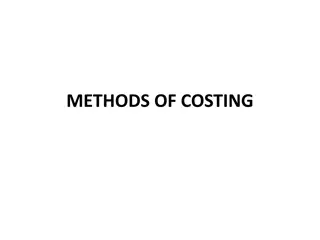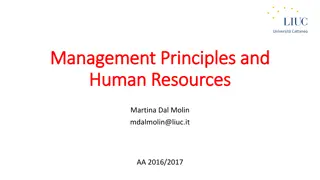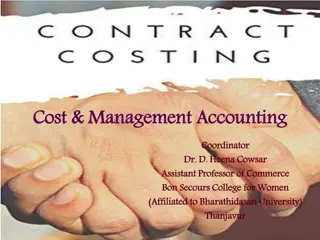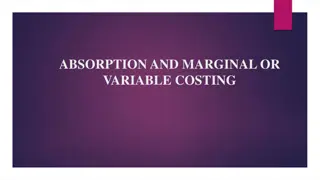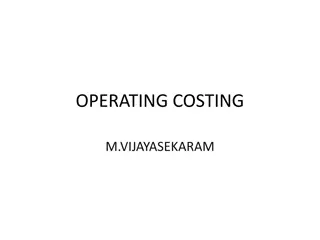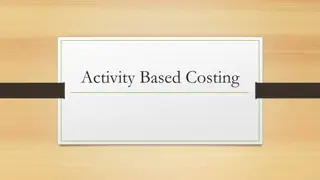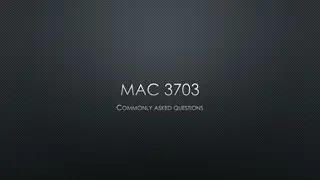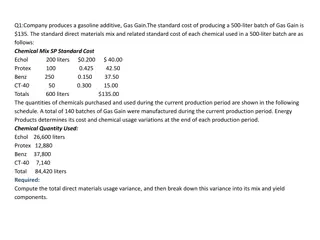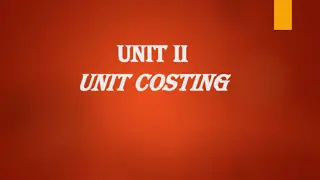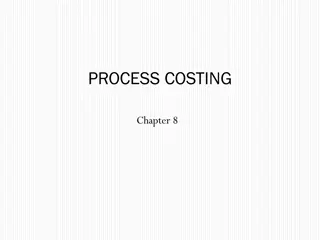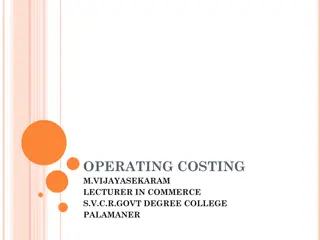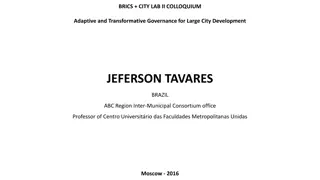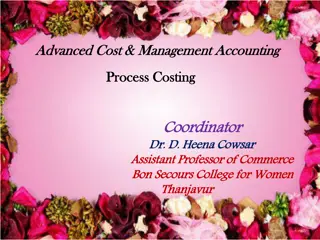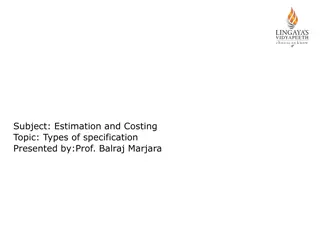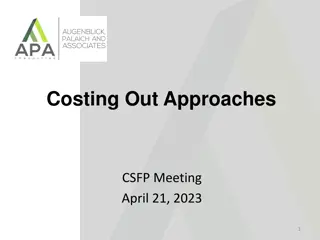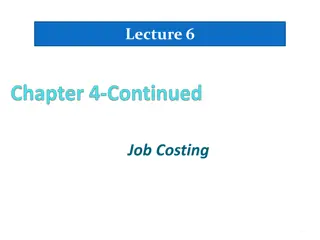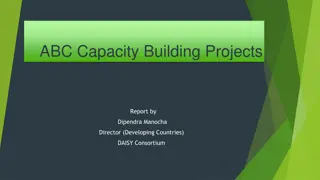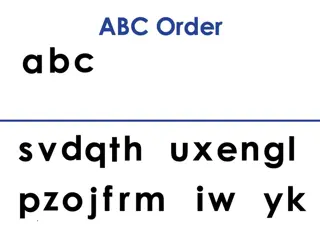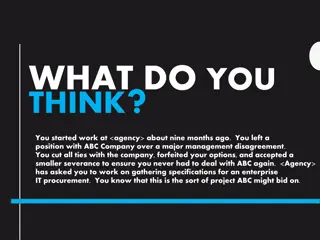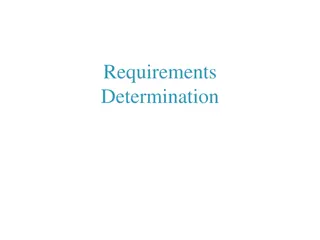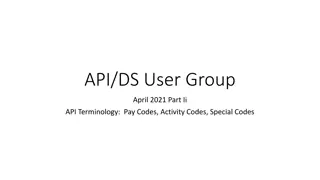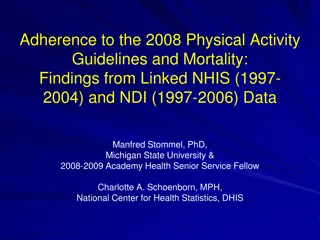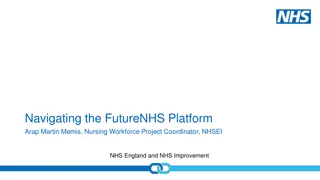Activity-Based Costing (ABC) in International Management: Methods and Analysis
Explore the application of Activity-Based Costing (ABC) in International Management, focusing on methods of assigning overheads, cost drivers, product and period costs, and value chain analysis. Dive into topics such as budgetary control systems, standard costing, flexible budgets, variance analysis, and budgeting techniques. Understand the process of identifying and assigning overhead costs across departments using various cost recovery rates and allocation methods.
Download Presentation

Please find below an Image/Link to download the presentation.
The content on the website is provided AS IS for your information and personal use only. It may not be sold, licensed, or shared on other websites without obtaining consent from the author. Download presentation by click this link. If you encounter any issues during the download, it is possible that the publisher has removed the file from their server.
E N D
Presentation Transcript
Traditional vs. Traditional vs. Based Costing (ABC) International Management International Management Accounting Accounting Activity Activity- -Based Costing (ABC) Prof. Dr. Marc Beutner TH K ln 4th Lecture SoSe 2023 Folie: 1
Methods of assigning overheads ABC steps and cost drivers, product and period costs value chain analysis What are we going to do? Finishing the rest of lecture 3 Activity-Based Costing (ABC) Budgetary control systems - Standard costing and variance Planning & controlling Flexible budget, variance and controlling Budgeting techniques and processes Cash flow budgets and company valuation Standard costing method Bowhill Ch. 7-9 Folie: 2
Step 1: finishing the rest of lecture 3 Activity-Based Costing (ABC) Methods of assigning overheads ABC steps and cost drivers, product and period costs value chain analysis Folie: 3
Graphic according to Bohill 2008 John Wiley & Sons Ltd. www.wileyeurope.com/college/bowhill Full or total costing Costing of products and services Folie: 4
Methods of assigning overheads Identifying overheads to be assigned using Blanket overhead rate, or Different cost recovery rate for different areas of organization Methods of "blanket overhead" cost recovery to product and services Cost per unit Cost per labour hour Cost per $ / / of labour Cost per machine hour Folie: 5
Graphic according to Bohill 2008 John Wiley & Sons Ltd. www.wileyeurope.com/college/bowhill Methods of assigning overheads 4 steps to overhead cost allocations across departments Folie: 6
Graphic according to Bohill 2008 John Wiley & Sons Ltd. www.wileyeurope.com/college/bowhill Methods of assigning overheads Step 1: Calculating departmental overhead rate Cost Basis of apportioning costs to cost centres Canteen costs Number of employees Rent /Heating and lighting Insurance Floor area Cost of assets in the department Folie: 7
Methods of assigning overheads Steps 2 to 4 Step 2: Costs of service departments needs to be reallocated to production departments Calculate separate overhead rate for each production department e.g. labour hour rate = Overhead/budgeted labour hours = $10000/1000 = $10/hour Assign overhead rate to each product or service e.g. 1,5 hours at $10/hour = $15 Step 3: Step 4: Folie: 8
Overhead allocation by department Example: Milton Ltd.s two distinct bicycle frames "Alto" requires 1,5 hours in the machine shop and 2 hours in the welding department "Special" requires 2 hours machine shop and 3 hours in welding Folie: 9
Methods of assigning overheads Example Folie: 10
Methods of assigning overheads Example Folie: 11
Methods of assigning overheads Example Step 1 Step 1: Overhead costs identified by department Folie: 12
Methods of assigning overheads Example Step 2 and 3 Step 2: Cost of support departments allocated to productive cost centres 20% 80% 35.341 from Stores ! Step 3: Calculate rate for each cost centre for assigning overheads to products Labour hours Slide 11! Labour hours Slide 11! Folie: 13
Methods of assigning overheads Example Step 4 Step 4: Assign cost centre costs to individual products Average full cost to make 1 Alto: Machine shop labor 1,5 hrs @ 6 per hour Welding cost centre labor 2 hrs @ 8 per hour Materials Direct costs 1.5 hrs in machine shop @ 16,09 per hour 2 hrs in welding department @ 10,22 per hour Overhead cost Total cost 9,00 16,00 50,00 24,03 20,44 75,00 44,47 119,47 Folie: 14
Methods of assigning overheads Example Step 4 Step 4: Assign cost centre costs to individual products Average full cost to make 1 Special: Machine shop labor 2 hrs @ 6 per hour Welding cost centre labor 3 hrs @ 8 per hour Materials Direct costs 2 hrs in machine shop @ 16,09 per hour 3 hrs in welding department @ 10,22 per hour Overhead cost Total cost 12,00 24,00 60,00 32,18 30,66 96,00 62,84 158,84 Folie: 15
ABC Costing Again we will have a look at Milton Ltd. And the bicycle frames / producs Alto and Special But now, we are using a different approach: ABC Costing Folie: 16
ABC Steps Step 1 Identify activities Step 2 Assign costs to activities Step 3 Identify cost drivers and respective cost- driver rates Step 4 Compute the cost per unit product or service Folie: 17
ABC Costing Example Step 1 ABC Step 1: Identify activities Folie: 18
ABC Costing Example Step 2 ABC Step 2: Assigning costs to activities Folie: 19
ABC Costing Example Step 3 ABC Step 3: Identify cost drivers for each activity and their respective cost-driver rates Folie: 20
ABC Costing Example Step 3 ABC Step 3: Identify cost drivers for each activity and their respective cost-driver rates Folie: 21
ABC Costing Example Step 3 ABC Step 3: Identify cost drivers for each activity and their respective cost-driver rates Cost-driver usage given 2600 units of product A (Alto) and 400 units of product B (Specials) Folie: 22
ABC Costing Example Step 3 ABC Step 3: Activity Cost driver rate Folie: 23
ABC Costing Example Step 4 ABC Step 4: Identify cost per unit product/service 2600 units of product A (Alto) and 400 units of product B (Specials) slide 22 Folie: 24
ABC Costing Example Step 4 Therefore Alto s total ABC-calculated unit cost Question 1: What about for the bicycle frame Special? Question 2: How do the results of ABC analysis differ from traditional full-costing? Please, explain. Folie: 25
Ideal scenarios for ABC application Proportionally high indirect costs and majority fixed i.e. do not increase directly with volumes Diverse range of products, consuming resources in different proportions Intense competition necessitates more accurate costing Lastly, ABC is extremely useful for Analyzing profitability and identifying cost-saving opportunities For entire company and for separate cost objects e.g. customer account profitability Folie: 26
Costing methods differ by industry Job costing: each unit of product or service is unique (HW1 Mr Jones, the painter) Batch costing: a finite amount of units is produced for each unique product (e.g. furniture production) Contract costing: A system of job costing used for long-term contracts (e.g. shipbuilding) Process costing: when a continuous stream of identical units are produced through the same stages (e.g. oil refineries) Folie: 27
Graphic according to Bohill 2008 John Wiley & Sons Ltd. www.wileyeurope.com/college/bowhill Value-chain analysis Primary activities: Inbound logistics, operations, outbound logistics, marketing & sales, service Secondary activities: Firm infrastructure, human resource mgt, (HRM), procurement, technology/product/service development Folie: 28
Cost behaviour and value-chain activities Cost structure of businesses and industries evolved over last few decades Proportion of direct manufacturing an operational costs decreased Increasing importance of indirect costs e.g. research and development (R&D), information technology (IT) to distribution, marketing and customer service With the advent of internet and media-oriented activities many costs do not necessarily change in proportion to volume of products or services produced Folie: 29
Competitive benchmarking and cost cutting: People Express Cost per seat mile was $1.35 less than United Airlines due to strategic decisions in the following .ve areas: Pre-arrival and airport operations (ticket counter, gate operations, baggage handling) ($0.42 per seat mile) Costs associated with aircraft ($0.18 per seat mile) Flight operations (pilots and .ight crew) ($0.40 per seat mile) Cabin operations ($0.32 per seat mile) Marketing and sales ($0.03 per seat mile) =) Could they have achieved this with traditional full costing? Folie: 30
What are we going to do? Budgetary control systems - Standard costing and variance Planning & controlling Flexible budget, variance and controlling Budgeting techniques and processes Cash flow budgets and company valuation Standard costing method Bowhill Ch. 7-9 Folie: 31
Definition: Definition: quantification of of a plan, for a a defined defined period period of of time Bohill Bohill, , page page 155 A A budget budget is is a a quantification for a plan, time 155 Folie: 32
Planning Planning and Controlling and Controlling Folie: 33
Learning Outcomes Understand the objectives of budgeting and controlling Describe and derive various budgeting techniques Calculate and interpret flexible budgets and variances based on standard costs Describe various production processes and controlling approaches Folie: 34
Graphic according to Bohill 2008 John Wiley & Sons Ltd. www.wileyeurope.com/college/bowhill Planning and controlling - I Long-term planning 1. Where is the business today? 2. Establish objectives 3. Search for alternative ways ("strategies") to achieve objectives 4. Evaluate options and select appropriate or optimal one 5. Prepare long-term (multi-year) business plan Folie: 35
Graphic according to Bohill 2008 John Wiley & Sons Ltd. www.wileyeurope.com/college/bowhill Planning and controlling - I Long-term planning tn t1 t5 t0 t2 t3 t4 Folie: 36
Graphic according to Bohill 2008 John Wiley & Sons Ltd. www.wileyeurope.com/college/bowhill Planning and controlling - II Annual planning and controlling 1. Prepare annual plans and performance targets 2. Quantify plans in form of budgets 3. Monitor actual results and identify variances 4. Respond to variances and adjust course of action Folie: 37
Graphic according to Bohill 2008 John Wiley & Sons Ltd. www.wileyeurope.com/college/bowhill Planning and controlling - II Annual planning and controlling tn t1 t5 t0 t2 t3 t4 Folie: 38
Budget Budget reviews reviews: : On a On a regular regular basis organisations organisations review and and the the budget budget for order order to to identify basis ( (probably probably every review the the actual actual oucome for the the remainder remainder of of the identify if if the the original original budget every three oucome for three months months) ) most for the the year the financial financial year budget will will be be achieved most to date year in achieved. . year to date in If If it it is is not not likely likely to corrections corrections may This is is know know as as forward to be may be forward control Bohill Bohill, , page page 156 156 be achieved achieved then be taken taken. . control. . then This Folie: 39
Information according to Bohill 2008 John Wiley & Sons Ltd. www.wileyeurope.com/college/bowhill Example: Budget P&L for Dundee Bicycles division for period April 20X8 to Mar 20X9 = 1851 production cost Folie: 40
Potential benefits of budgeting Improved planning Improved coordination and communication Improved control of the actions of organizations Improved evaluation of the performance of managers Higher motivation of staff Folie: 41
Information according to Bohill 2008 John Wiley & Sons Ltd. www.wileyeurope.com/college/bowhill Recall the conditions in which ABC may be appropriate Indirect costs are a high proportion of total costs. There is a diverse range of products or services provided. There is competition and accurate costing is needed for pricing and in order to eliminate non- value-adding activities Activity-Based Costing (ABC) Folie: 42
Information according to Bohill 2008 John Wiley & Sons Ltd. www.wileyeurope.com/college/bowhill Administration of a budget Responsibility accounting Responsibility centres Profit Cost Revenue Investment Folie: 43
Flexible Budget Flexible Budget A flexible A flexible budget budget is is the change change in the original original budget in the the actual actual level budget adjusted adjusted for level of of activity activity. . for the the Folie: 44
Original vs. flexible budget Note: To follow Bowhill.s terminology, define variances as (-) when they reduce profits (Adverse Variance i.e. when revenue decrease or costs increase) versus (+) when they increase profits (Favorable variance i.e. when revenue increase or costs decrease) Folie: 45
Adverse and favourable variance If actual revenue is less than budget then this is an adverse variance. If actual revenue is greater than budget then this is a favourable variance. If actual cost is greater than budget then this is an adverse. If actual cost is less than budget then this is a favourable variance. (Bohill, p. 160) Folie: 46
Just a short own calculation example Calculate the variance Quarter Jul Sep 2012 Variance summary (1000 ) Units Material Direct Cost Commercial Fixed Cost Original Budget 6500 164,2 20,4 Flexible Budget 5800 148,2 20,4 Actual 5800 152,1 37,2 Variance ? A ? A Folie: 47
Just a short own calculation example Please, check the variance: +? -? Quarter Jul Sep 2012 Variance summary (1000 ) Units Material Direct Cost Commercial Fixed Cost Original Budget 6500 164,2 20,4 Flexible Budget 5800 148,2 20,4 Actual 5800 147,1 37,2 Variance +1,1 A -16,8 A Folie: 48


